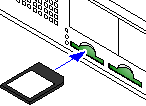|
Before inserting the System SD card and starting the system, check the following: a.Ensure that you have the correct type of Avaya System SD card. b.Check that the ID number printed on the card matches the number against which licenses have been issued. c.Ensure that the card has the required level of software. If necessary, upgrade the card using IP Office Manager. |
Inserting the System SD card:
1.With the control unit shut down:
i.The SD card slots are covered by a plastic tab. Partially release the screw holding the tab so that it can be moved clear of the System SD card slot.
ii.Insert the card into the slot labeled System SD.
2.Apply power to any external expansion modules.
•! Important: External Expansion Module Power
In order to be detected and operated correctly, external expansion modules must start before the IP Office control unit. Normally this achieved by connected all expansion modules to the same power strip as the control unit. The control unit applies a short delay to its own start-up process to ensure that expansion modules powered on at the same time as it are detected.
3.Apply power to the control unit. The power outlet used must include a switch and the power outlet must have a protective earth connection.
4.The control unit loads firmware from the System SD card with which it upgrades itself and its internal components.
5.The LED's on any base card in the system will go through a sequence of being solid red for a minute, then flashing red for 2 minutes. This sequence will then repeat. In total this process takes approximately 6 minutes (future restarts not involving any software update take approximately 2 minutes).
6.The end of this process is indicated by LED1 on each base card flashing every orange every 5 seconds. This is the systems normal healthy heartbeat indication. On base cards with a trunk daughter card fitted, LED9 also flashes every 5 seconds.
7.The control unit then begins upgrading the external expansion modules if necessary. This is indicated by the center LED on the module flashing red. This process is completed when the LED changes to steady green.
8.If a configuration file is already present on the System SD card it is loaded by the IP Office. If not, new systems create a default configuration and copy that configuration onto the System SD card.

